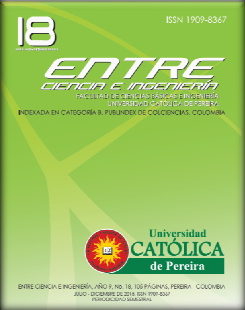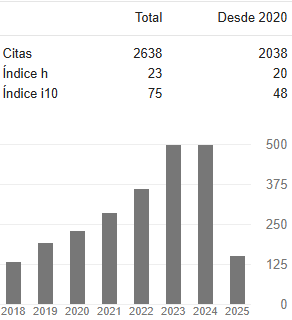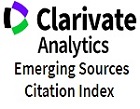Modeling the interaction energy of silica nanoparticles prepared in microemulsions
DOI:
https://doi.org/10.31908/19098367.566Keywords:
colloidal stability, nanoparticles, silica, microemulsions, DLVO theoryAbstract
The interaction energy of silica nanoparticles prepared in microemulsions of organic phase was modeled, using the DLVO theory for spherical particles of equal size. For this purpose, the effect of the organic solvent and the surface active agent (surfactant) used for the coating of the nanomaterials was evaluated. The selected commercial surfactants were the sodium bis-(2-ethylhexyl) sulfosuccinate (AOT) and the p-(1, 1, 3, 3-tetramethylbutyl) phenyl (TX-100). The colloidal systems studied were cyclohexane/AOT, cyclohexane/TX-100, isooctane/AOT, and isooctane/TX-100. Curves of total energy contribution were analyzed considering the interaction energy of van der Waals attraction and repulsion energy due to osmotic layer covering surfactant molecules to the nanoparticles. From these analyzes the curves of total energy for several diameters of nanoparticles as a function of their separation distance were built. These results were compared with the thermal energy of the system, indicating greater stability for the colloidal silica nanoparticles model covered with the TX-100 surfactant and suspended in the organic medium cyclohexane. Thus, it could be expected that the combination of the chemical compounds cyclohexane/TX-100 allow the formation of reverse micelles, which serve for the synthesis of silica nanoparticle providing control size, as well as a system with a good colloidal stability.
Downloads
References
K. Margulis-Goshen, and K. Magdassi, Organic nanoparticles from microemulsions: Formation and applications, Current Opinion in Colloid & Interface Science vol. 17, no.5., pp. 290-296, Oct. 2012.
M. Ahmad, M. Younus, and M. Ali, Microemulsion method: A novel route to synthesize organic and inorganic nanomaterials: 1st Nano Update, Arabian Journal of Chemistry, vol. 5, no.4. pp. 397–417, Oct. 2012.
C. Barrera, A. P. Herrera, N. Bezares, E. Fachini, R. Olayo-Valles, J. P. Hinestroza, and C. Rinaldi, Effect of poly(ethylene oxide)-silane graft molecular weight on the colloidal properties of iron oxide nanoparticles for biomedical applications, Journal of colloid and interface science, vol. 377, no.1., pp. 40-50. Jul. 2012.
S. R. Rao, Surface Chemistry of Froth Flotation, Vol. I, New York, Fundamentals Springer Science & Business, Kluwer Academic/ Plenium Publishers, 2013, pp. 15-17.
A. Herrera, O. Resto, J. G. Briano, and C. Rinald, Synthesis and agglomeration of gold nanoparticles in reverse micelles, Nanotechnology, vol. 16, no.7., pp. 618-625, Jun. 2005.
C. H. Achebe, and S. N. Omenyi, Mathematical Determination of the Critical Absolute Hamaker Constant of the Serum (As an Intervening Medium) Which Favours Repulsion in the Human Immunodeficiency Virus (HIV)-Blood Interactions Mechanism, Proceedings of the World Congress on Engineering Vol II, London, U.K, 2013.
N. Jaramillo, C. Paucar, and C. García, Influence of the reaction time and the Triton x-100/Cyclohexane/Methanol/HO ratio on the morphology and size of silica nanoparticles synthesized via sol-gel assisted by reverse micelle microemulsion, Journal of Materials Science vol. 49, no.9, pp. 3400-3406, May. 2014.
K. In-Yong, E. Joachim, H. Choi, and K. Kim, K, Toxicity of silica nanoparticles depends on size, dose, and cell type. Nanomedicine: Nanotechnology, Biology and Medicine vol. 11, no.6, pp. 1407–1416. Aug. 2015.
M. C. Llinás, and D. Sánchez-García, Nanopartículas de sílice: preparación y aplicaciones en biomedicina, Afinidad vol. 71, no.565, pp. 20-31, Dic. 2014.
V. Médout-Marére, A Simple Experimental Way of Measuring the Hamaker Constant A11 of Divided Solids by Immersion Calorimetry in Apolar Liquids, Journal of Colloid and Interface Science, vol. 228, no.2, pp. 434–437, Aug. 2000.
S. Eichenlaub, C. Chan, and S. P. Beaudoin, Hamaker Constants in Integrated Circuit Metalization, Journal of Colloid and Interface Science, vol. 248, pp. 389–397, Apr. 2002.
J. B. Rosenholm, K. E. Peiponen, and E. Gornov, Materials cohesion and interaction forces, Advances in Colloid and Interface Science, vol. 141, no.(1–2), pp. 48–65, Sep. 2008.
T. F. Tadros, Rheology of Dispersions Principles and Applications, Wiley-VCH, United Kingdom, 2011, p. 25.
R. Porcel, A. B. Jódar, M. A. Cabrerizo, R. Hidalgo-Alvarez, and A. Martín-Rodríguez, Sequential Adsorption of Triton X-100 and Sodium Dodecyl Sulfate onto Positively and Negatively Charged Polystyrene Latexes, Journal of Colloid and Interface Science, vol. 239, pp. 568–576, Jul. 2001.
M. A. La-Scalea, C. M. S. Menezes, and E. I. Ferreira, Molecular volume calculation using AM1 semi-empirical method toward diffusion coefficients and electrophoretic mobility estimates in aqueous solution, Journal of Molecular Structure: THEOCHEM, vol. 730, no.1, pp. 111-120, Oct. 2005.
A. R. Mustafina, J. G. Elistratova, O. D. Bochkova, V. A. Burilov, S. V. Fedorenko, A. I. Konovalov, and S. Y. Soloveva, “Temperature induced phase separation of luminescent silica nanoparticles in Triton X-100 solutions,” Journal of colloid and interface science, vol. 354, no.2, pp. 644-649. Feb. 2011.
L. P. Singh, S. K. Bhattacharyya, R. Kumar, G. Mishra, U. Sharma, G. Singh, and S. Ahalawat, Sol-Gel processing of silica nanoparticles and their applications. Advances in colloid and interface science, vol. 214, pp. 17-37, Dec. 2014.
C. Barrera, A. P. Herrera, and C. Rinaldi, “Colloidal dispersions of monodisperse magnetite nanoparticles modified with poly (ethylene glycol),” Journal of colloid and interface science, 329(1), 107-113, Jan. 2009.
A. A. Araújo, E. L. Barros, O. C. Filho, y E. L. Foletto, “Determinación de los parámetros del modelo de flory-huggins para estimación del punto de nube de surfactantes no iónicos,” Información Tecnológica, vol. 25, no.2, pp. 165-174, Dic. 2014.
Downloads
Published
Issue
Section
License
Copyright (c) 2019 Entre ciencia e ingeniería

This work is licensed under a Creative Commons Attribution-NonCommercial 4.0 International License.



















